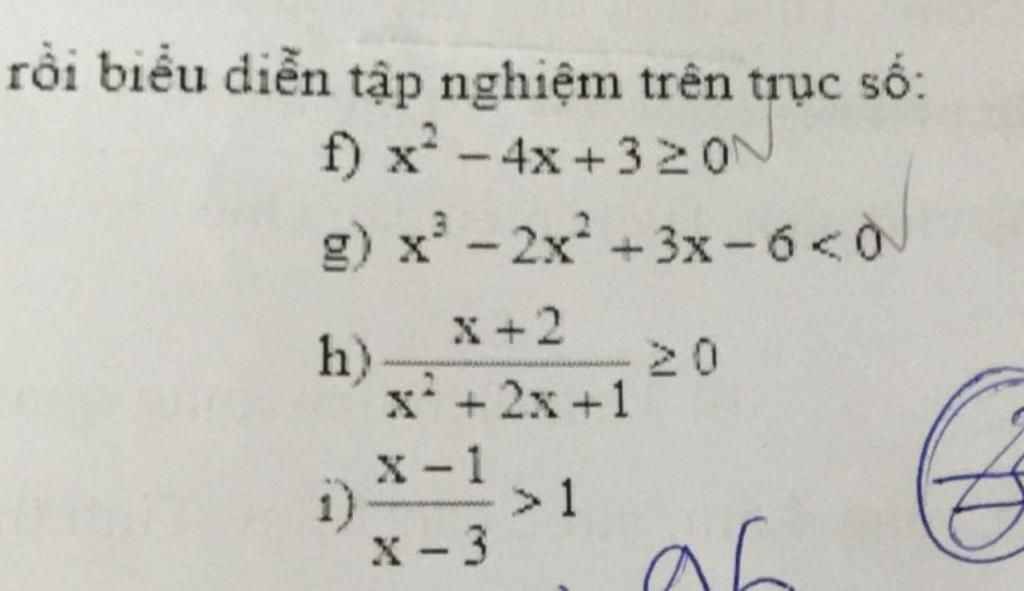đề bài: giải các bất phương trình sau: Giusp với ah:((( tí mik phải đi học rồiii

Hãy nhập câu hỏi của bạn vào đây, nếu là tài khoản VIP, bạn sẽ được ưu tiên trả lời.


Bài 1:
a) Ta có: \(2\left(3-4x\right)=10-\left(2x-5\right)\)
\(\Leftrightarrow6-8x-10+2x-5=0\)
\(\Leftrightarrow-6x+11=0\)
\(\Leftrightarrow-6x=-11\)
hay \(x=\dfrac{11}{6}\)
b) Ta có: \(3\left(2-4x\right)=11-\left(3x-1\right)\)
\(\Leftrightarrow6-12x-11+3x-1=0\)
\(\Leftrightarrow-9x-6=0\)
\(\Leftrightarrow-9x=6\)
hay \(x=-\dfrac{2}{3}\)

*Điều kiện để căn bậc hai có nghĩa: x>5/2
*Từ phương trình => (\(\sqrt{\frac{3x-1}{2x-5}}^{ }\) )^2=4
<=>\(\frac{3x-1}{2x-5}\)=4 <=>3x-1=4.(2x-5)
<=> 3x-1 = 8x - 20
<=>-5x=-19 <=>x=\(\frac{19}{5}\)

bài 1
\(\frac{x-1}{x+3}>0\) \(\left(x\ne-3\right)\)
TH1 \(\hept{\begin{cases}x-1>0\\x+3< 0\end{cases}}\)\(\Leftrightarrow\hept{\begin{cases}x>1\\x< -3\end{cases}}\)(vô lí)
TH2 \(\hept{\begin{cases}x-1< 0\\x+3>0\end{cases}}\)\(\Leftrightarrow\hept{\begin{cases}x< 1\\x>-3\end{cases}}\)\(\Rightarrow-3< x< 1\)
bài 2 . với dạng này ta áp dụng bđt \(|x|< A\Leftrightarrow\orbr{\begin{cases}x< -A\\x>A\end{cases}}\)
|x - 5| >2
\(\Leftrightarrow\orbr{\begin{cases}x-5>2\\x-5< -2\end{cases}}\)\(\Leftrightarrow\orbr{\begin{cases}x>7\\x< 3\end{cases}}\)
#mã mã#

=>5(4x-1)-2+x<=3(10x-3)
=>20x-5+x-2<=30x-9
=>21x-7<=30x-9
=>-9x<=-2
=>x>=2/9

Câu 1:
a) Ta có: 7x+21=0
\(\Leftrightarrow7x=-21\)
hay x=-3
Vậy: S={-3}
b) Ta có: 3x-2=2x-3
\(\Leftrightarrow3x-2-2x+3=0\)
\(\Leftrightarrow x+1=0\)
hay x=-1
Vậy: S={-1}
c) Ta có: 5x-2x-24=0
\(\Leftrightarrow3x=24\)
hay x=8
Vậy: S={8}
Câu 2:
a) Ta có: \(\left(2x+1\right)\left(x-1\right)=0\)
\(\Leftrightarrow\left[{}\begin{matrix}2x+1=0\\x-1=0\end{matrix}\right.\Leftrightarrow\left[{}\begin{matrix}2x=-1\\x=1\end{matrix}\right.\Leftrightarrow\left[{}\begin{matrix}x=-\dfrac{1}{2}\\x=1\end{matrix}\right.\)
Vậy: \(S=\left\{-\dfrac{1}{2};1\right\}\)
b) Ta có: \(\left(2x-3\right)\left(-x+7\right)=0\)
\(\Leftrightarrow\left[{}\begin{matrix}2x-3=0\\-x+7=0\end{matrix}\right.\Leftrightarrow\left[{}\begin{matrix}2x=3\\-x=-7\end{matrix}\right.\Leftrightarrow\left[{}\begin{matrix}x=\dfrac{3}{2}\\x=7\end{matrix}\right.\)
Vậy: \(S=\left\{\dfrac{3}{2};7\right\}\)
c) Ta có: \(\left(x+3\right)^3-9\left(x+3\right)=0\)
\(\Leftrightarrow\left(x+3\right)\left[\left(x+3\right)^2-9\right]=0\)
\(\Leftrightarrow\left(x+3\right)\left(x+3-3\right)\left(x+3+3\right)=0\)
\(\Leftrightarrow x\left(x+3\right)\left(x+6\right)=0\)
\(\Leftrightarrow\left[{}\begin{matrix}x=0\\x+3=0\\x+6=0\end{matrix}\right.\Leftrightarrow\left[{}\begin{matrix}x=0\\x=-3\\x=-6\end{matrix}\right.\)
Vậy: S={0;-3;-6}
f: =>(x-3)(x-1)>=0
=>x>=3 hoặc x<=1
g: =>(x-2)(x^2+3)<0
=>x-2<0
=>x<2
h: =>x+2>=0
=>x>=-2
i: =>(x-1-x+3)/(x-3)>0
=>x-3>0
=>x>3